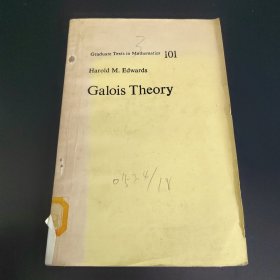
伽罗瓦理论(英文版)
全新正版 急速发货
¥ 28.8 9.9折 ¥ 29 全新
库存11件
天津武清
认证卖家担保交易快速发货售后保障
作者(美)爱德华滋 著
出版社世界图书出版公司
ISBN9787510027420
出版时间2010-09
装帧平装
开本其他
定价29元
货号20959456
上书时间2024-11-28
- 在售商品 暂无
- 平均发货时间 14小时
- 好评率 暂无
- 最新上架
商品详情
- 品相描述:全新
- 商品描述
-
导语摘要
This exposition of Galois theory was originally going to be Chapter I of the continuation of my book Ferrnat's Last Theorem, but it soon outgrew any reasonable bounds for an introductory chapter, and I decided to make it a separate book. However, this decision was prompted by more than just the length. Following the precepts of my sermon "Read the Masters!" [E2], Imade the reading of Galois' original memoir a major part of my study of Galois theory, and I saw that the modern treatments of Galois theory lacked much of the simplicity and clarity of the original. Therefore I wanted to write about the theory in a way that would not only explain it, but explain it in terms close enough to Galois' own to make his memoir accessible to the reader, in the same way that I tried to make Riemann's memoir on the zeta function and Kummer's papers on Fermat's Last Theorem accessible in my earlier books, [Eli and [E3]. Clearly I could not do this within the confines of one expository chapter
目录
acknowledgments xiii
1. galois 2. influence of lagrange 3. quadratic equations 4.1700 n.c. to a.o. 1500 5. solution of cubic 6. solution of quartic 7.impossibility of quintic 8. newton 9. symmetric polynomials in roots 10. fundamental theorem on symmetric polynomials 11. proof 12.newton's theorem 13. discriminants
first exercise set
14. solution of cubic 15. lagrange and vandermonde 16. lagrange resolvents 17. solution of quartic again 18. attempt at quintic ~19.lagrange's rdfiexions
second exercise set
20. cyciotomic equations 21. the cases n = 3, 5 22. n = 7, 11 23.general case 24. two lemmas 25. gauss's method ~26. p-gons by ruler and compass 27. summary
third exercise set
28. resolvents 29. lagrange's theorem 30. proof 31. galois resolvents 32. existence of galois resolvents 33. representation of the splitting field as k(t) ~34. simple algebraic extensions 35. euclidean algorithm 36. construction of simple algebraic extensions 37. galois'method
fourth exercise set
38. review 39. finite permutation groups 40. subgroups, normal subgroups 41. the gaiois group of an equation 42. examples
fifth exercise set
43. solvability by radicals 44. reduction of the galois group by a cyclic extension 45. solvable groups 46. reduction to a normal subgroup ofindex p 47. theorem on solution by radicals (assuming roots of unity)48. summary
sixth exercise set
49. splitting fields 50. fundamental theorem of algebra (so-called) 51.construction of a splitting field 52. need for a factorization method 53.three theorems on factorization methods 54. uniqueness offactorization of polynomials 55. factorization over z 56. over q 57. gauss's lemma, factorization over q 58. over transcendental extensions 59.of polynomials in two variables 60. over algebraic extensions 61. final remarks
seventh exercise set
62. review of galois theory ~63. fundamental theorem of galois theory(so-called) 64. galois group of xp - 1 = 0 over q 65. solvability of the cyclotomic equation 66. theorem on solution by radicals 67.equations with literal coefficients 68. equations of prime degree 69.galois group of xn- 1 = 0 over q 70. proof of the main proposition 71. deduction of lemma 2 of24
eighth exercise set
appendix 1. memoir on the conditions for solvability of equations by radicals, by evariste galois
appendix 2. synopsis
appendix 3. groups
内容摘要
This exposition of Galois theory was originally going to be Chapter I of the continuation of my book Ferrnat's Last Theorem, but it soon outgrew any reasonable bounds for an introductory chapter, and I decided to make it a separate book. However, this decision was prompted by more than just the length. Following the precepts of my sermon "Read the Masters!" [E2], Imade the reading of Galois' original memoir a major part of my study of Galois theory, and I saw that the modern treatments of Galois theory lacked much of the simplicity and clarity of the original. Therefore I wanted to write about the theory in a way that would not only explain it, but explain it in terms close enough to Galois' own to make his memoir accessible to the reader, in the same way that I tried to make Riemann's memoir on the zeta function and Kummer's papers on Fermat's Last Theorem accessible in my earlier books, [Eli and [E3]. Clearly I could not do this within the confines of one expository chapter
相关推荐
— 没有更多了 —






















以下为对购买帮助不大的评价